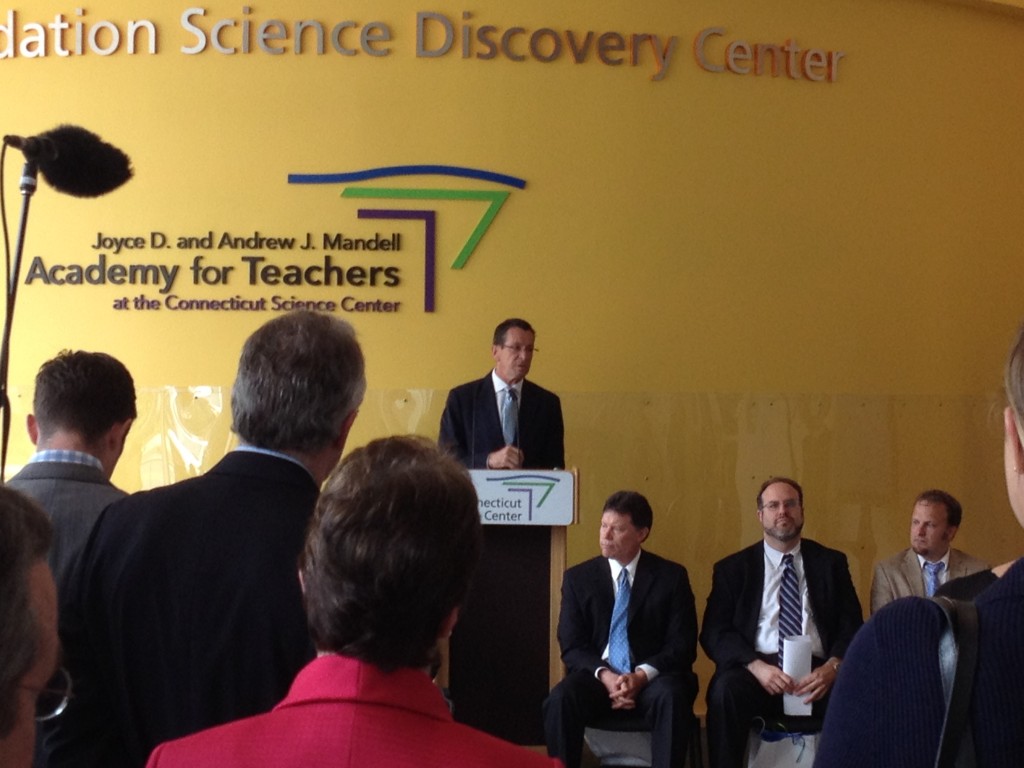Teacher Training in STEM Fields to Expand in CT
/
Connecticut’s drive to improve both teacher training and the caliber of Science, Technology, Engineering and Math (STEM) education being provided to students across the state received a boost with the announcement that the Connecticut Science Center would be tripling the capacity of its teacher professional development program, the result of a grant from Joyce D. and Andrew J. Mandell.
The number of teachers participating in the program will increase from 500 to 1,500 annually over the next few years, officials said, with the goal of giving educators the tools they need to meet rigorous new state and national standards for STEM education and core curricula.
Governor Dannel Malloy, State Education Commissioner Stephan Pryor, Hartford Mayor Pedro Segarra and Hartford’s 2012 Teacher of the Year Keith Sevigny,  a past participant in the professional development program, were among those joining Connecticut Science Center President and CEO Matt Fleury in making the announcement.
a past participant in the professional development program, were among those joining Connecticut Science Center President and CEO Matt Fleury in making the announcement.
In addition to expanding its capacity to serve more teachers, the newly named Joyce D. and Andrew J. Mandell Academy for Teachers at the Connecticut Science Center will also award graduate-level college credit through Charter Oak State College for certain programs. Academy offerings include Student Engagement Strategies, Inquiry Teaching and Learning, STEM Education Units, Science Content Workshops, Engineering Practices, and Science Coaching. Teachers completing the covered courses can earn a total of nine credits toward their Master’s degrees over a three-year period.
Governor Malloy said the announcement made it a day of “celebration,” emphasizing that the impact “will be played out in the years to come.” Reiterating his commitment to education and economic development, the Governor said this effort is another example of initiatives designed to “allow our state to compete.” He noted the BioScience Connecticut initiative and recently approved growth plans for the University of Connecticut as further indications of the state’s commitment.
Described as a “high-impact professional development program for educators,” the Academy is “committed to supplying educators with professional development experiences that support rigorous science and curriculum standards.” Commissioner Pryor, underscoring the challenges in education, pointed out that “15 countries do better than the U.S. in science and 24 do better in math.” Pryor added that “we can prepare students for jobs of the future, but not if we are slipping in math and science.”
Officials pointed out that new nationally mandated benchmarks such as the Next Generation Science Standards and Common Core Education Standards will require teachers to seek training to improve the way they teach science and integrate it with the rest o f their curriculum.
“We want every child in the state to be able to compete,” said Joyce Mandell. “Teaching teachers how to connect with their students is one of the most important things we’ve ever done. We’re very proud of our association with the Connecticut Science Center.”
Citing a story published in U.S. News, the website CT Stem Jobs, reported last month that about 20 percent of all American jobs are now in the science, technology, engineering and mathematics fields, with half of those open to workers who don't have a four-year college degree, according to a new report by the Brookings Institution called "The Hidden STEM Economy."
Those jobs constitute a "hidden STEM economy," the Washington, D.C.-based think tank says, because they are "prevalent in every large metropolitan area," but many people believe at least a bachelor's degree is necessary to work in careers that require STEM skills. Many of these so-called "blue-collar" stem jobs are in construction, installation, manufacturing and health care. They include registered nurses, mechanics, carpenters and electricians.
"Of the $4.3 billion spent annually by the federal government on STEM education and training, only one-fifth goes towards supporting sub-bachelor's level training, while twice as much supports bachelor's or higher level-STEM careers," the report says. "The vast majority of National Science Foundation spending ignores community colleges. In fact, STEM knowledge offers attractive wage and job opportunities to many workers with a post-secondary certificate or associate's degree."





























